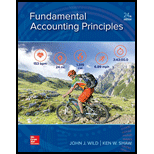
Sub Part-1
Bonds Issuance:
The Bonds issuance by the company is a source of long term financing and is issued at a discount or premium depending the prevailing market rate of interest and stated rate of interest on bonds. When the stated rate of interest is higher than the market rate of interest, then the investors will be ready to invest only in the situation when the bonds are issued at premium. This premium on bonds issue shall be treated as income by deducting the amortized portion from the cash interest paid to arrive at the interest expense of the period.
The
Sub Part-2
Straight line Amortization of Premium:
The Straight line amortization of Premium is a technique of writing off the total discount over a period of bonds with an equal amount on each interest period. This equal amount can be computed by dividing the total amount of discount by the number of interest periods over a life of bonds.
The cash interest, straight line amortized premium and Interest expense for each interest period to be computed.
Sub-Part 3
Total interest expense over the life of bonds:
The total interest expense over the life off bonds can be computed by the adding up the all the amount paid over the lifetime of the bonds i.e. cash interest payment and maturity
The Total interest expenses over the life of bonds.
Sub Part-4
Amortization table:
The amortization table under
The Preparation of amortization schedule.
Sub Part-5
Accounting treatment of interest payment and amortized discount:
The Accounting entry required to be passed at each interest period is debiting the total interest expense as per amortization chart and also, Premium on bonds payable is debited for the amount of premium amortized and credit being made to the cash account for cash interest paid.
The Journal entries of interest expenses for two interest periods.
Want to see the full answer?
Check out a sample textbook solution
Chapter 14 Solutions
FUND.ACCT.PRIN.(LOOSELEAF)-W/ACCESS
- Genshin Company uses process costing. During March, the packaging department had 8,500 units in beginning work-in-process inventory that were 70% complete. During the month, 42,000 units were started and 37,500 units were completed. Ending work-in-process inventory was 40% complete. Using the weighted-average method, what are the equivalent units for the month? Need helparrow_forwardCan you solve this general accounting question with accurate accounting calculations?arrow_forwardIn 2019, Philip Industries sold 3,800 units at $275 each. Variable costs were $195 per unit, and fixed costs were $120,000. What was Philip Industries' 2019 net income?arrow_forward
- Please explain the correct approach for solving this financial accounting question.arrow_forwardA machine costs $50,000 with a salvage value of $5,000 and a useful life of 5 years. Calculate the annual depreciation expense using straight-line, double-declining balance, and sum-of-years-digits methods.arrow_forwardNirvana Technologies has $85,000 in assets. They also have $32,000 in liabilities and $8,500 in expenses, and they paid out $10,000 in dividends this year. The extended accounting equation is assets = liabilities + (revenue - (expenses + dividends)). What would their revenue need to be for their accounts to be in balance?arrow_forward
- I need help solving this general accounting question with the proper methodology.arrow_forwardI am looking for the correct answer to this general accounting question with appropriate explanations.arrow_forwardI am looking for help with this financial accounting question using proper accounting standards.arrow_forward
- Accounting solution pleasearrow_forwardPlease help me solve this general accounting question using the right accounting principles.arrow_forwardAbigail Industries uses a perpetual inventory system. Beginning inventory consisted of 600 units at $24 each. During the month, the following transactions occurred: Purchase #1: 800 units at $25; Sale #1: 900 units at $40; Purchase #2: 700 units at $26; Sale #2: 850 units at $42. Using the FIFO method, what is the gross profit for the month?arrow_forward

 AccountingAccountingISBN:9781337272094Author:WARREN, Carl S., Reeve, James M., Duchac, Jonathan E.Publisher:Cengage Learning,
AccountingAccountingISBN:9781337272094Author:WARREN, Carl S., Reeve, James M., Duchac, Jonathan E.Publisher:Cengage Learning, Accounting Information SystemsAccountingISBN:9781337619202Author:Hall, James A.Publisher:Cengage Learning,
Accounting Information SystemsAccountingISBN:9781337619202Author:Hall, James A.Publisher:Cengage Learning, Horngren's Cost Accounting: A Managerial Emphasis...AccountingISBN:9780134475585Author:Srikant M. Datar, Madhav V. RajanPublisher:PEARSON
Horngren's Cost Accounting: A Managerial Emphasis...AccountingISBN:9780134475585Author:Srikant M. Datar, Madhav V. RajanPublisher:PEARSON Intermediate AccountingAccountingISBN:9781259722660Author:J. David Spiceland, Mark W. Nelson, Wayne M ThomasPublisher:McGraw-Hill Education
Intermediate AccountingAccountingISBN:9781259722660Author:J. David Spiceland, Mark W. Nelson, Wayne M ThomasPublisher:McGraw-Hill Education Financial and Managerial AccountingAccountingISBN:9781259726705Author:John J Wild, Ken W. Shaw, Barbara Chiappetta Fundamental Accounting PrinciplesPublisher:McGraw-Hill Education
Financial and Managerial AccountingAccountingISBN:9781259726705Author:John J Wild, Ken W. Shaw, Barbara Chiappetta Fundamental Accounting PrinciplesPublisher:McGraw-Hill Education





